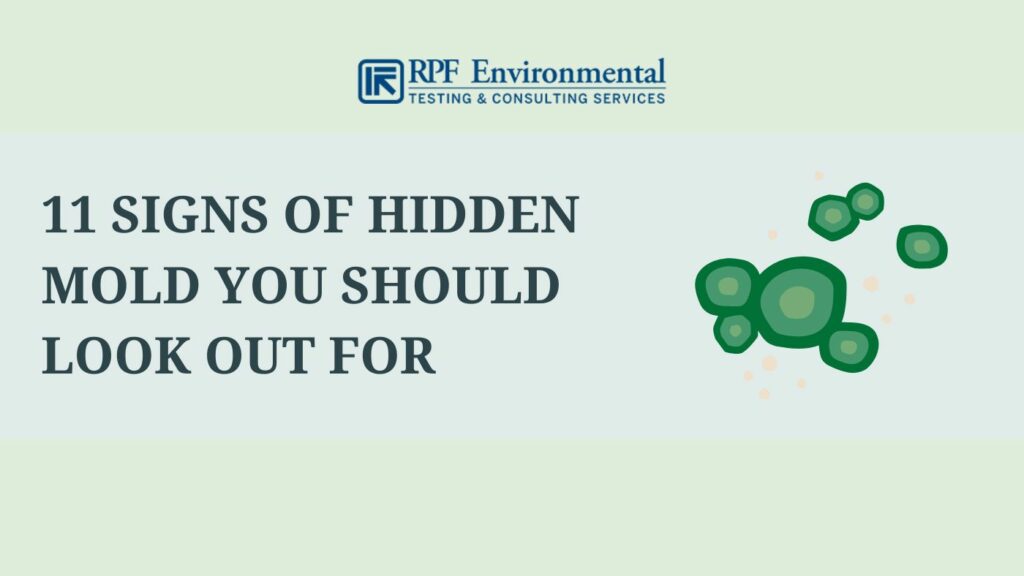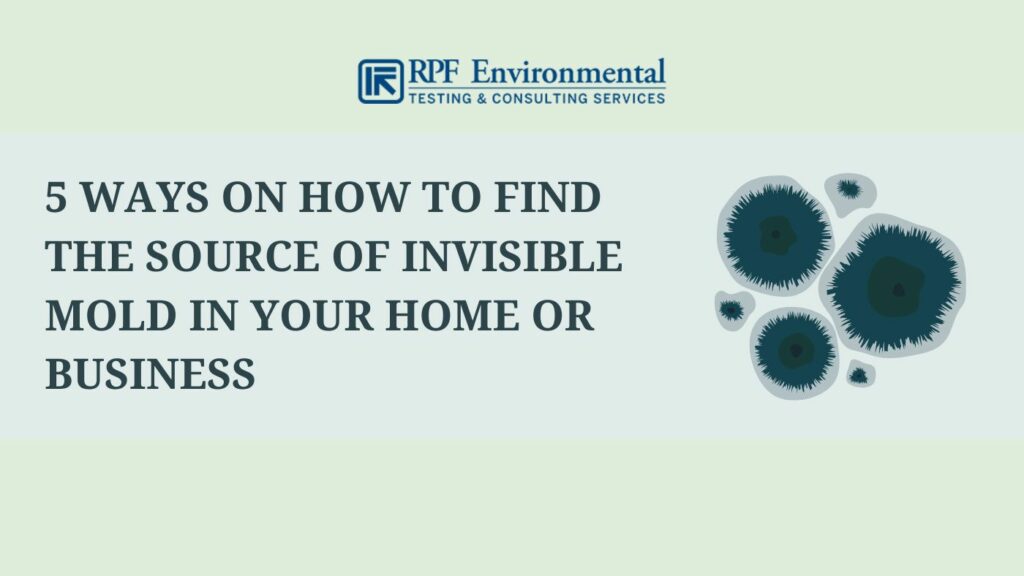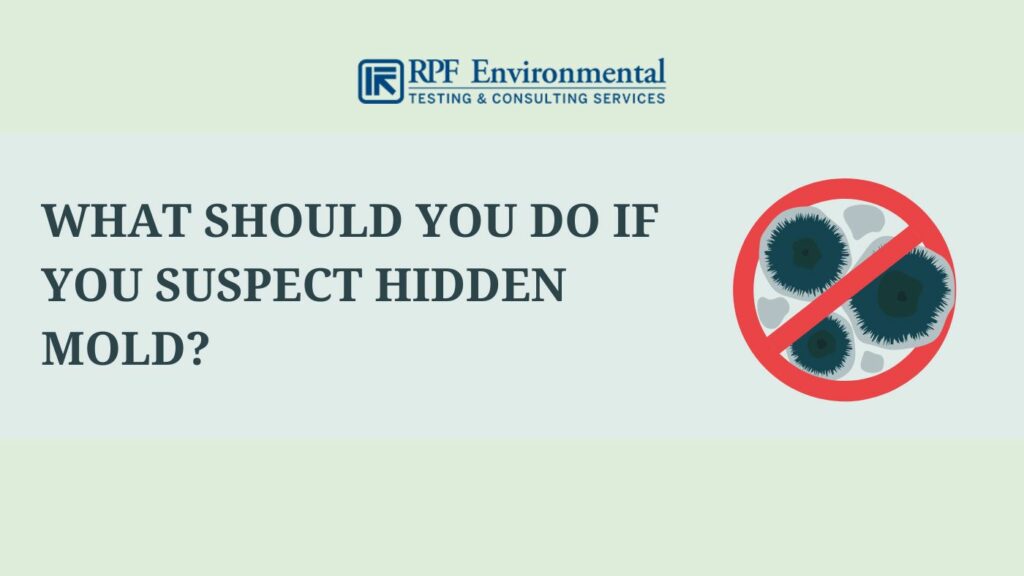As a homeowner, it’s important to keep an eye out for hidden mold in your house to prevent it from spreading further. Although it’s not always easy to identify, there are certain signs that can indicate the presence of mold.
In this article, we’ll cover what to look for and how to find hidden mold in your house so that you can take the necessary steps to get rid of it and protect your home and family.

RPF Environmental can help you with finding hidden mold in your house or business through our professional mold inspection services. We have served clients in Illinois, Indiana, Maine, Massachusetts, New Hampshire, and across the nation.
11 Signs of Hidden Mold You Should Look Out For

Here are 11 signs that may indicate the growth of hidden mold inside your home:
1. Visible Mold Spores
Seeing mold spores in your home is obviously the most noticeable sign of mold infestation. If you are seeing a lot, the infestation might already be at its worse.
2. Dark Spots on Surfaces
Check surfaces, especially your walls, for dark spots that look like stains or discolorations. Take note that mold can come in any color and texture. The most common colors are black and green and often look slightly furry, but they also tend to be wet and slimy.
3. Musty, Damp, or Earthy Smell
Mold usually smells musty, damp, or earthy, but worse infestations have a more pungent smell like rotten meat or sweaty socks. However, a moldy smell is not always an indication of mold growth. Make sure to search for other sources that might be causing the smell like wet laundry and rotting food. Professional mold testing is always recommended to identify and confirm invisible mold in your home.
4. Allergic Reactions
If your seasonal allergy never goes away and worsens when you’re home, you might be experiencing mold allergy symptoms due to hidden mold.
Symptoms of hidden mold include:
- Stuffy or runny nose
- Itchy throat
- Itchy eyes
- Skin irritation (burning or itching sensation)
- Dry skin
5. Struggle With Respiratory Issues
Inhaling mold spores can cause more severe health complications, especially for individuals with existing conditions. Once the spores enter your lungs, they can worsen asthma symptoms and cause respiratory infections. This can lead to shortness of breath as well as severe coughing and sneezing.
The worst case is when the fungus starts to grow in your lungs which causes additional symptoms like chest pain, fever, and coughing up blood. If this happens, seek medical attention and have your home inspected for mold promptly.
6. Your HVAC System Smells Weird
Damp and dark HVAC systems are among the common areas where you can find mold in homes. So if you can smell something musty from your HVAC system after turning it on and you noticed dark spots on its filter, it might be contaminated by mold. We recommend installing HEPA filters in your HVAC to remove airborne mold spores in your home.
7. Warped Walls
If you notice warping, bubbling, cracking, or any surface abnormalities on your walls, there is a possibility of mold growth caused by these moisture problems. So before the problem gets worse, find where the moisture is coming from like leaky plumbing or windowsills and causes of humidity. Once you have fixed the issue, clean and dry your walls thoroughly before repainting them.
8. Dark Tile Grout
Dark grout in your shower tiles may indicate mold growth. In many cases, it is most likely caused by trapped water vapor in your bathroom due to poor ventilation. But if you experienced recent flooding and leaks, you might be dealing with toxic mold. If this happens, consult a mold testing and remediation professional to deal with the issue.
9. Squishy Floor
Moisture problems in your subfloor can cause some parts of your floor to be “squishy” and there is a chance that mold is already growing. If there is no easy way for you to access your subfloor, you might need to pull up some parts of your flooring to check for mold growth. You can clean the mold yourself if the growth is not widespread, but we recommend working with a professional to guarantee complete mold infestation removal.
10. Uneven Attic Insulation
A leaking roof will cause your attic insulation to become uneven. Also, improper ventilation in the area along with moisture issues create an ideal condition for mold to grow. So if your attic insulation looks very lumpy, you might be dealing with mold growth too.
11. Past Flooding in Your Home
If your home has experienced flooding in the past, there is a big chance that mold is already growing in your space. Although mold may not immediately grow after the flooding occurs, mold can still grow after a long time and can lead to severe infestations. So, you may want to check previously flooded areas for mold.
5 Ways on How to Find the Source of Invisible Mold in Your Home or Business

Fixing the signs of mold growth alone won’t solve the problem. You need to find the main source of the issue to completely eliminate hidden mold growth. Below are five methods you can follow to identify the source of mold in your home or business:
1. Identify the Source of the Musty Odor
Musty or earthy smells mean that the mold might be growing in a damp and dark corner without ventilation. Worse mold growths will smell more pungent, especially if you are near the source. Look out for unpleasant smells when you pass through specific areas in your house/work area and find where they are coming from.
2. Look for Moisture Problems and Leakages
Moisture is the main cause of mold growth, so checking for moisture issues and leakages is one of the most effective ways in finding the source of hidden mold. Search for signs of moisture damage like warped walls, identify the cause, and fix it as soon as possible. Check for nearby leaks on your plumbing fixtures too such as on your water pipes and waste lines. Also, make sure that you identify the actual source of the leak.
3. Check Your Ductwork
If you can’t find leakages or moisture problems but still notice a moldy smell or see visible mold growths, the problem might be on improperly insulated ductwork. Uninsulated ducts can cause condensation and the water can find its way to your attic and drywall. This will cause mold to start growing and multiply if not fixed immediately. Installing a vapor barrier to protect your ducts would be the best solution for this.
4. Search Places Where Hidden Mold Can Thrive
Most types of mold only need moisture, a food source, and a dark environment to grow. So, you will often find them in hidden areas in your home where there is not much traffic. Places that experienced past flooding or water damage as well as those prone to dampness and leaks are also susceptible to mold growth. Below are common areas where you can find mold in your home or business:
Common Areas Where Mold Can Grow
- Basements
- Kitchens (especially areas prone to spills)
- Attics
- Bathrooms (tile grout, under sinks and toilets, shower curtain, etc.)
- Crawlspaces
- Ceilings
- Near plumbing
- Air ducts
- Window sills
- Behind appliances and furniture
- Door frames
- Insulation materials
- Under drawers and furniture
- Inside wall cavities
5. Look Under Your Carpeting
Lastly, check for rust and stains on and under your carpet that may have been caused by past leaks in the area. You might also find hidden mold on your floor or subflooring where the carpeting is. Mold infestations on carpeting are often hard to clean, so the best solution is to throw it away.
Causes of Hidden Mold & How to Prevent It
As we’ve mentioned earlier, moisture issues are the main cause of mold growth. These are commonly due to a history of flooding, leakages in your plumbing, and improperly insulated ductwork. The only way you can get rid of mold in your home is by fixing these issues and ensuring that you have removed the roots of the mold to prevent them from reoccurring.
What Should You Do If You Suspect Hidden Mold?

Dealing with hidden mold should be left to certified professionals. Professional mold testing companies like RPF Environmental can help you identify the source of the mold accurately to ensure that the infestation will be completely dealt with. If you can’t find the source or are not sure how to do proper mold remediation, it is always recommended to consult a professional.
FAQs
Yes, mold spores are tiny and invisible to the naked eye. They may be floating around your home without you knowing and grow on dark and damp surfaces where you’re not expecting them to.
Find what is causing the mold growth such as moisture problems and fix it. Also, clean up the mold up to its roots by using soap and water or other natural solutions like vinegar, hydrogen peroxide, and baking soda. We do not recommend using bleach to kill mold. If the infestation is widespread, call a professional.
Identify the source of the moldy smell, look for moisture intrusions and leakages, and search areas where mold can grow. Read more on our discussion on the ways to find hidden mold here.
Yes, inhaling invisible spores caused by hidden mold can cause health complications, especially for immunocompromised individuals, young children, and the elderly. It can cause allergic reactions and respiratory problems in the long run.
Conclusion
Hidden mold can be tricky and not easy to find and deal with. So if you see the signs of hidden mold we have mentioned here, contact a professional now. Hiring a certified mold inspection and remediation company is important to get accurate test results and ensure effective mold removal.
RPF Environmental specializes in mold and indoor air quality testing for homes, businesses, and other institutions using state-of-the-art technology. We have been serving areas nationwide like Maine, Massachusetts, and New Hampshire for many years so you can trust us. Contact us now!




